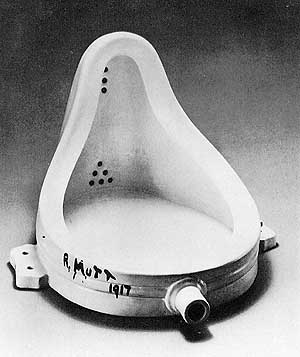



I found the passage on the bottom of page 115 and the top of 116 in Fry's "Art and Socialism" to be particularly intriguing. Fry describes how new ideas in art are often rejected until an intermediary takes the new idea and "disinfects" it for the masses by merging the new idea with an old idea, and then is hailed as a genius.
The artist that immediately popped into my head was Andy Warhol. Roger Fry's point applies perfectly to the art and fame of Warhol.
Warhol's art, the art that is so original for being unoriginal, actually has its roots in Marcel Duchamp's "readymades." A particularly notorious one is Duchamp's 1917 "sculpture" entitled Fountain, which is little more than a urinal. Needless to say, people were shocked and organizers of the art exhibit to which Fountain was submitted refused to show it. Duchamp also painted L.H.O.O.Q. in 1919, which features da Vinci's Mona Lisa with a mustache.
Now fast forward to 1964. Andy Warhol unveils his take on sculpture with Brillo Box. Warhol has taken Duchamp's idea, but merged it with advertising, thus sanitizing it and making it presentable to the masses. He also follows Duchamp's lead of copying Mona Lisa, only Warhol decides to copy another famous lady: Marilyn Monroe. Once again, Duchamp's concept has been sanitized and merged with pop cultural nostalgia.
Today, Warhol is considered to be a genius. I don't know about you, but the first time I heard about Marcel Duchamp was in relation to Andy Warhol, that Duchamp "was an influence." This leads fans of Warhol to go back to Duchamp, consider his work, and possibly accept it.
Roger Fry was certainly right. This leads me to wonder, what would Fry think of the boy genius Andy Warhol?
(pictured from top: Brillo Box Andy Warhol, 1964; Marilyn Andy Warhol, 1967; L.H.O.O.Q. Marcel Duchamp, 1919; Fountain Marcel Duchamp, 1917)


